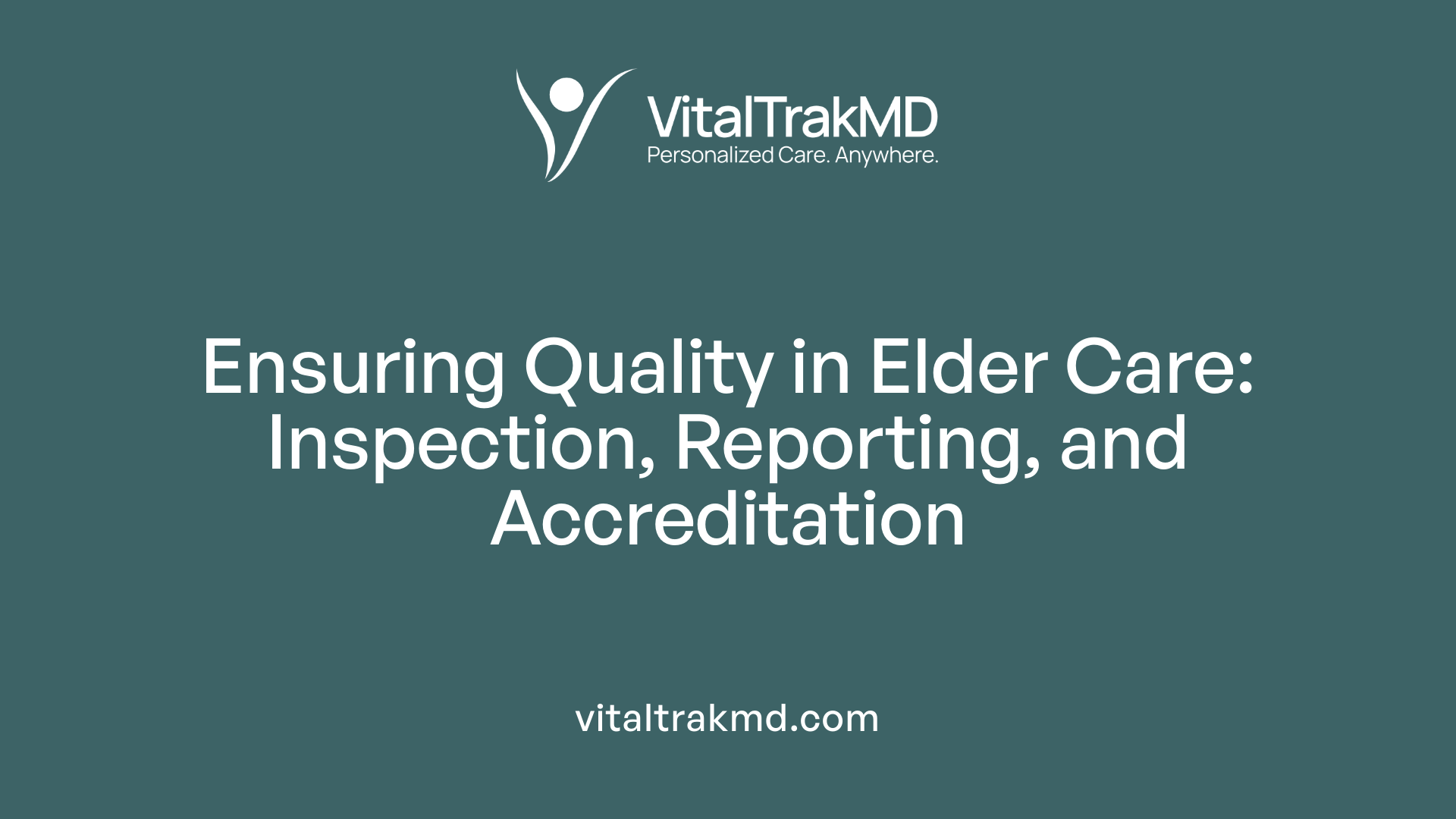Harnessing Accountability to Improve Long-Term Senior Health

A Call for Systemic Improvements in Long-Term Senior Care
With the growing aging population and escalating costs, effective accountability measures are critical to ensuring quality, safety, and dignity in long-term elder care. From legislative reforms to technological innovations, multiple strategies can be harnessed to improve outcomes and rebuild trust in elder care systems.
Regulatory Frameworks and Legislative Reforms

What regulatory and legislative efforts are in place to improve care quality and safety in long-term elder care?
In Ontario, the Long-Term Care Homes Act, 2007 (LTCHA), is the primary regulation governing LTC homes. Effective since July 2010, it replaced previous laws and introduced standards emphasizing resident safety, individualized care plans, and clinical assessment procedures. The Act mandates compliance inspections, Resident Quality Inspections—including engagement with residents and families—and unannounced checks to ensure standards are maintained.
Financial accountability in Ontario is managed through regional health authorities called LHINs, which allocate funding based on staffing, services, and accommodations. Performance measurement tools like the Resident Assessment Instrument – Minimum Data Set (RAI-MDS) collect data on residents’ health, functioning, and quality of life to monitor and improve care quality.
Public accountability is maintained through the Ministry of Health and Long-Term Care’s data reporting, complaint channels, and performance reports from agencies such as Healthcare Ontario. Many LTC homes also participate voluntarily in accreditation programs like Accreditation Canada, which emphasizes quality and risk management.
Elsewhere in the US, federal laws like the Omnibus Budget Reconciliation Act of 1987 (OBRA '87) set nationwide standards for nursing home care, including minimum staffing levels, resident rights, and quality measures.
More recently, the Biden-Harris Administration has enacted three final rules to support care quality:
| Policy Area | Description | Impact |
|---|---|---|
| Minimum Staffing Standards | Mandates at least 3.48 hours of care per resident daily, with a registered nurse on site 24/7 | Enhances resident care and supports staff |
| Transparency & Payment | Sets minimum payments for direct care staff, improves rate disclosures | Improves workforce stability and accountability |
| Safety & Quality | Mandates safety protocols, staffing oversight, and quality metrics | Ensures safer care environments |
In Ontario, the legislative response to recent challenges is exemplified by the Fixing Long-Term Care Act, 2021. This law emphasizes emergency preparedness, outbreak management, staffing requirements, and increased penalties for non-compliance. It also introduces provisions for small housing models and workforce development.
Collectively, these policies aim to elevate elder care quality, improve safety, and foster transparency. They reflect a shared goal of holding LTC providers accountable while safeguarding residents’ rights and well-being.
Accountability Dimensions in Elder Care

How can technology and innovations support aging in place and improve senior health outcomes?
Advancements in healthcare technology have transformed elder care by enabling seniors to stay in their homes longer and maintain independence. Remote health monitoring systems, such as wearable devices and sensor-based safety nets, provide real-time data on vital signs and activity levels. AI-powered tools assist in early detection of health risks like falls or medical emergencies, facilitating timely interventions.
These innovations also support virtual visits, easing social isolation and enabling continuous medical consultation without leaving home. Smart home systems and mobile applications help coordinate caregiving tasks, share health data, and manage medications, which collectively contribute to better health management and improved quality of life for seniors.
What measures exist to enforce accountability and ensure quality in senior care?
Ensuring high standards in elder care involves a multi-layered approach. Regular, unannounced inspections by regulatory bodies identify compliance issues and enforce standards. Public reporting mechanisms, such as government-quality reports and complaint portals, promote transparency and inform consumer choices.
Accreditation programs, like those overseen by Accreditation Canada, emphasize quality assurance and risk management. Facilities often voluntarily seek accreditation to demonstrate commitment to excellence. Penalties and enforcement actions, including fines and license suspensions for violations, serve as deterrents against substandard care.
What measurement systems and assessments are used to monitor senior health?
Monitoring senior health relies on comprehensive, standardized assessment tools. The Resident Assessment Instrument – Minimum Data Set (RAI-MDS) is widely used to collect detailed data on residents’ clinical status, functionality, and quality of life. This system allows care providers to develop personalized care plans and monitor outcomes over time.
Data from RAI-MDS and similar tools support performance measurement initiatives, helping identify areas for improvement. Combining clinical assessments with feedback from residents and families helps ensure that elder care continuously adapts to meet the evolving needs of the aging population.
More Information
Search query: [
Technology and Innovation in Elder Care
How are measurement systems and assessments used to monitor and improve senior health in long-term care settings?
Assessment tools such as the Geriatric Depression Scale (GDS), the Barthel Index, and the Resident Assessment Instrument – Minimum Data Set (RAI-MDS) play a crucial role in elder care. These standardized instruments enable healthcare providers to identify early signs of depression, declining functional abilities, or other health issues.
By collecting comprehensive data across physical, mental, and social domains, clinicians can develop tailored care plans for each resident. Regular assessments allow staff to monitor changes over time, evaluate the effectiveness of interventions, and make data-driven improvements to care quality.
This systematic approach ensures that elder care is responsive and personalized, leading to better health outcomes and enhanced safety for residents.
What initiatives and collaborative efforts promote transparency and accountability in long-term care sectors?
Several initiatives aim to increase transparency and hold long-term care providers accountable. The State Nursing Home Innovation & Transparency Learning Collaborative (LTCCC) is a prominent example. It works across multiple states, including California, Kentucky, Michigan, Oregon, and Virginia, to implement strategies that improve public reporting of care quality and safety measures.
These efforts often involve sharing data openly, encouraging peer learning, and adopting best practices. Federal policies, such as new staffing standards and ownership disclosures, also reinforce accountability.
Furthermore, public performance reports from agencies like Healthcare Ontario and accreditation programs like Accreditation Canada assist families and regulators in making informed decisions. Collectively, these initiatives foster a culture of transparency, aiming to improve elder care quality at systemic levels.
Adoption of Telemedicine, Remote Monitoring, AI, and Robotics
Technology adoption has Accelerated in elder care, especially post-pandemic. Telemedicine allows residents to consult healthcare professionals remotely, reducing unnecessary hospital visits. Remote monitoring devices track vital signs, detect falls, and alert staff to emergencies, enabling prompt intervention.
Artificial Intelligence (AI) and robotics are emerging to predict health changes, assist with daily activities, and support socialization. For example, AI-based systems can analyze patterns indicating dementia progression or fall risks, facilitating early response.
Robots are also used in some settings to provide companionship, assist with mobility, or deliver medications, improving independence and reducing caregiver burdens.
Virtual Visits to Reduce Social Isolation
Social isolation has serious health implications for older adults, including increased risks of dementia and heart disease. Virtual visitation platforms like Zoom and FaceTime have become vital tools during the COVID-19 pandemic.
These virtual visits enable residents to maintain contact with family and friends safely. Facilities often set up dedicated spaces or provide devices to facilitate these connections, mitigating loneliness and supporting mental health.
Assistive Tools for Medication and Emergency Response
Various assistive devices support elder independence and safety. These include medication management apps that remind residents to take medications and alert caregivers to missed doses.
Emergency response systems, such as wearable alert devices, enable residents to summon help instantly in case of falls or other emergencies. Smart home technologies, like automated lighting and voice-activated assistants, further enhance safety.
Barriers and Enablers like Literacy and Privacy Concerns
Despite advancements, barriers like low digital literacy among some seniors and privacy concerns hinder technology adoption. Educating residents and caregivers about device use is vital.
Privacy issues related to data security and consent also require careful handling, especially with remote monitoring and AI applications. Addressing these barriers through training and robust privacy policies is essential to fully realize the benefits of elder care innovations.
Leadership and Systemic Improvements

What leadership practices and systemic improvements can strengthen accountability in elder care?
Effective leadership in elder care hinges on models like transformational and servant leadership. Transformational leaders inspire staff by setting a compelling vision for quality and safety, encouraging innovation and empowering workers to advocate for residents. Servant leadership emphasizes serving staff and residents first, fostering trust and moral responsibility.
Building a culture of safety and transparency is crucial. This involves regular communication, open reporting of errors or concerns, and involving staff and residents in decision-making. Such practices cultivate an environment where accountability is embedded in daily routines.
System reforms also play a vital role. Innovative approaches like dementia villages create specialized, community-like settings that support autonomy and social engagement. Community-based care models extend services into local neighborhoods, fostering accessible, person-centered care.
Engaged staff who understand their role in safety and quality are essential. Strategies include ongoing training, performance incentives linked to quality metrics, and clear accountability channels. Regular audits, public reporting, and accreditation help maintain high standards and provide external oversight.
What research exists on the impact of accountability measures on senior health and care quality?
Studies demonstrate that accountability initiatives, including public reporting and accreditation, improve compliance, safety, and overall quality outcomes. For example, enhanced transparency encourages facilities to meet or exceed standards, which benefits residents.
However, challenges remain. Limited resources, staffing shortages, and oversight gaps can hinder effective accountability. Some research suggests that without adequate funding and support, accountability measures alone may not sufficiently improve senior health. Integrating leadership practices with systemic reforms and resource allocation is essential to sustain meaningful improvements.
| Aspect | Impact | Key Challenges | Systemic Solutions |
|---|---|---|---|
| Leadership | Enhances staff motivation, safety culture | Resistance to change, resource constraints | Training programs, leadership development |
| Transparency | Builds trust, accountability | Data inaccuracies, privacy concerns | Robust reporting systems, stakeholder engagement |
| Innovative Care Models | Person-centered, community integration | High costs, regulatory barriers | Policy support, pilot programs |
| Staff Engagement | Better care quality, lower turnover | Burnout, low wages | Competitive pay, professional growth opportunities |
Understanding the interconnectedness of leadership practices and systemic reforms is vital in fostering an accountable, high-quality elder care environment across North America.
Legal Rights, Protections, and Enforcement in Senior Care
What legal rights, protections, and enforcement strategies ensure accountability and quality in senior care?
Legal protections are vital tools to ensure seniors receive safe, respectful, and high-quality care. In many jurisdictions, laws such as the Elder Abuse and Dependent Adult Civil Protection Act serve as comprehensive statutes that protect vulnerable adults from abuse, neglect, and exploitation.
These laws establish the rights of seniors, including the right to be free from physical, emotional, or financial abuse. They also outline the responsibilities of caregivers and care providers, emphasizing the importance of maintaining dignity and safety.
Mandatory reporting laws require certain professionals—like healthcare workers, social workers, and even some family members—to report suspected abuse or neglect immediately. These statutes aim to activate oversight agencies and law enforcement when abuse is suspected.
Enforcement mechanisms include investigations conducted by agencies such as Adult Protective Services (APS) or equivalent bodies. These agencies assess reports of abuse, enforce protective actions like removing victims from harmful environments, and ensure caregivers are held accountable.
Legal remedies for victims extend beyond protective actions. Victims or their advocates can seek damages through civil lawsuits, pursue guardianship or conservatorship to safeguard their interests, or engage advocacy groups to help navigate legal processes.
Combined, these protections and enforcement strategies create a framework that promotes accountability, improves care quality, and ensures that seniors' rights are upheld. They also serve as a deterrent against neglect and abuse, contributing to safer, more respectful elder care environments.
For further understanding, exploring topics like elder law protections in both Canada and the US can provide comparative insights into how different jurisdictions uphold senior rights and enforce accountability,
Community-Based Initiatives and Future Directions
What initiatives and collaborative efforts promote transparency and accountability in long-term care sectors?
Various collaborative efforts are actively working to enhance transparency and accountability in long-term care. For example, the State Nursing Home Innovation & Transparency Learning Collaborative brings together multiple states like California, Kentucky, Michigan, Oregon, and Virginia to share strategies and develop initiatives aimed at improving nursing home transparency and accountability.
Nonprofit organizations play a significant role as well. The Long-Term Care Community Coalition (LTCCC) conducts systemic advocacy, research, and policy recommendations to address issues such as staffing, quality of care, and resource allocation. Additionally, local Long-Term Care (LTC) Ombudsman Programs, like those in the Hudson Valley and Tri-County in New York, advocate for residents, investigate complaints, and promote resident rights.
These combined efforts aim to increase data transparency, ensure residents' rights are protected, and promote continuous improvements in care quality.
What approaches can be used to reform nursing homes and long-term care facilities through accountability mechanisms?
Reforming nursing homes necessitates a multifaceted approach centered around accountability. Implementing outcome-based funding models aligns financial incentives with quality care outcomes. Increasing transparency involves making staffing levels, ownership structures, and quality metrics publicly accessible.
Independent oversight agencies and stricter enforcement of regulations are crucial for ensuring compliance. Elevating staffing standards, especially for registered nurses, has shown to improve patient care and safety, particularly during crises like COVID-19.
Resident engagement and participation in care planning foster a person-centered environment and generate feedback to inform quality improvements. These strategies, combined with regular inspections, reporting mechanisms, and enforcement of penalties for violations, can drive the long-term reform of elder care services.
Future directions and innovations in elder care
Looking ahead, technology will play an increasingly vital role in elder care. Telehealth, AI, and remote monitoring systems can enhance safety, improve diagnostics, and support independence. Policy innovations such as expanding funding for workforce training, developing new models like small house nursing homes, and strengthening protections for vulnerable populations are also projected to improve the sector.
The ongoing pandemic has underscored the need for resilient, well-staffed, and transparent elder care systems. Future efforts will likely focus on integrating these technological and policy advances with a stronger emphasis on residents' rights and quality of life.
Impacts of the COVID-19 pandemic on elder care
The COVID-19 crisis revealed critical vulnerabilities within long-term care, including underfunded staffing, inadequate infection control, and reliance on crisis responders. As a response, many jurisdictions increased staffing requirements, stockpiled PPE, and utilized partnerships between hospitals and nursing homes to reduce mortality.
Virtual visits and safe visitation protocols have been introduced to combat social isolation, which negatively affects residents' health. Moreover, technology adoption accelerated, enabling remote monitoring and increased communication.
The pandemic emphasized the importance of accountability, preparedness, and innovation, prompting ongoing reforms aimed at protecting residents and ensuring resilient elder care systems.
Building a Sustainable and Just Eldercare System
Achieving high-quality, safe, and dignified long-term care for seniors hinges on robust accountability across regulatory, clinical, financial, and community domains. Embracing legislative reforms, leveraging technological innovations, fostering leadership excellence, and empowering residents and families are key to building a sustainable, equitable elder care system that honors the rights and needs of aging populations.
References
- Approaches to Accountability in Long-Term Care - PMC
- Governor Healey Signs Bill Improving Access to High-Quality Care ...
- Fitzpatrick, Trahan Unveil Bipartisan Caring for Our Seniors Act to ...
- Watching care behind closed doors: upward and downward ...
- Biden-Harris Administration Takes Historic Action to Increase ... - CMS
- Whose Accountability Matters in Long-Term Care? - PMC
- About LTCCC - NursingHome411
- Harnessing technology to improve public health outcomes
- Experts Offer 10 Ways to Reform and Improve Nursing Homes - AARP
Recent articles
Want to Feel Better and Live Healthier?
Join hundreds of patients taking control of their health with personalized care that fits their life – not the other way around.
Rated 4.8/5 by 32+ customers







